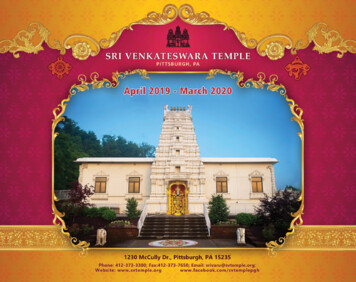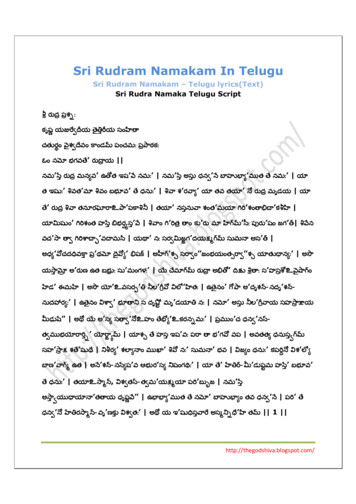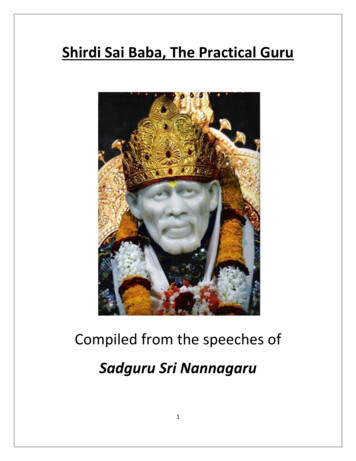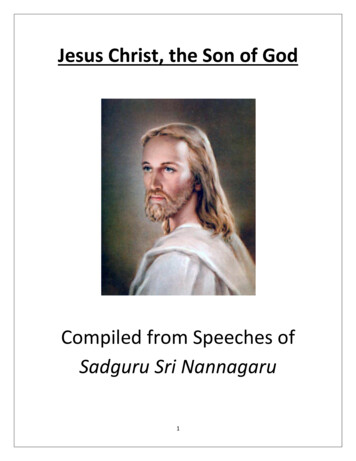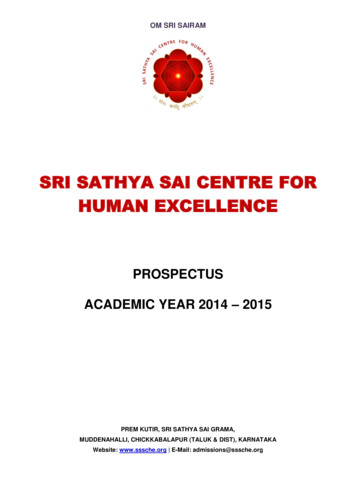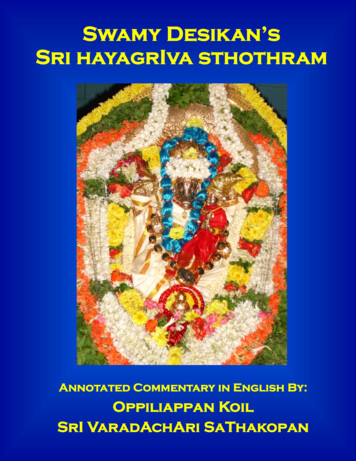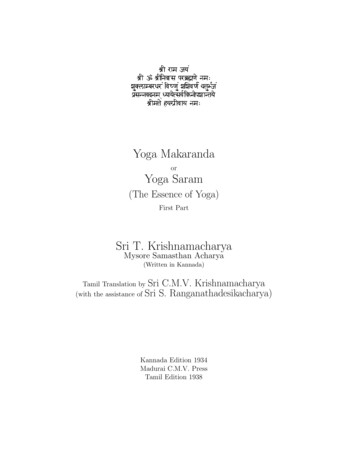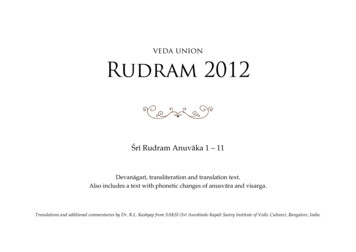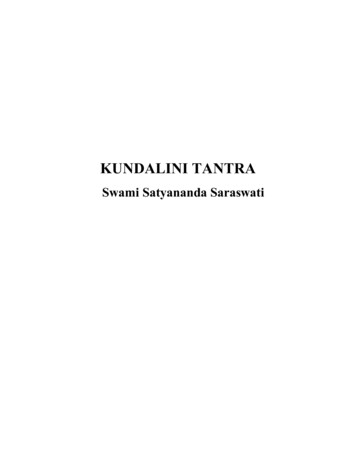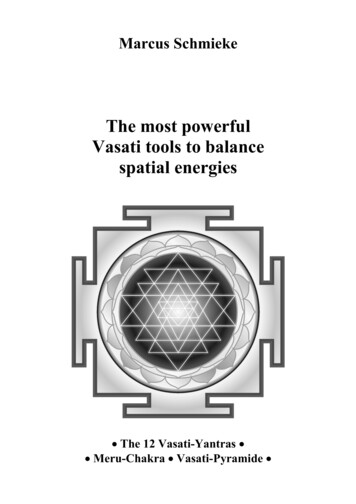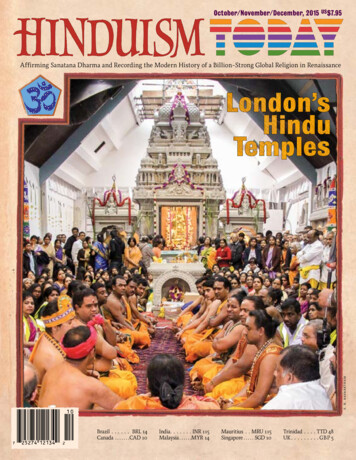
Transcription
October/November/December, 2015 US 7.95u xhCFCHEy12134mzVv,:!s . n. n ava r at h a mAffirming Sanatana Dharma and Recording the Modern History of a Billion-Strong Global Religion in RenaissanceBrazil . . . . . . . BRL 14Canada . . . . . . . CAD 10India . . . . . . INR 115Malaysia . . . . . MYR 14Mauritius . . MRU 115Singapore . . . . . SGD 10Trinidad . . . . TTD 48UK . . . . . . . . GB P 5
TRADITIONLondon: A Sri Lankan Citadel of SaivismThe Tamil Hindus’ dedication for their beloved Lord Murugan has madeLondon the largest bastion of Saivite Hinduism in the Western worldBy Ramai and VatshalanSanthirapala, Londonondon is famed for its rich culture, racial diversity and regal history, recently capturing the attentionof Forbes magazine, which deemed itthe world’s most influential city. Inside thiscosmopolitan metropolis an untold Hindustory of equal fascination emerges. In thisarticle, we chronicle the immigration ofSaivite Hinduism to London from Sri Lanka’sJaffna Peninsula, the journey from one islandin the Indian Ocean to another 5,000 milesaway. An estimated 300,000 Tamils residein the UK, the densest concentration in theWestern world, the majority of them withinLondon itself. Most have immigrated fromSri Lanka; a minority hail from India, Malaysia, South Africa, Mauritius and Singapore.This homogenous concentration has provided a unique community enabling Saivismto flourish and remain true to its orthodoxprinciples. London is today home to at least56h i n d u i s m t o dayvat s h a l a n s a n t h i r a pa l aL23 Saivite temples, all founded by Sri LankanTamils in the last 40 years, many hidden inside unassuming English exteriors. Throughthese holy structures, the rich power of theTamil faith flows out, making London theWest’s most prominent Saivite bastion.o c t o b e r / nov e m b e r / d e c e m b e r , 2 0 1 5The History of Tamil ImmigrationsHistorically Tamils in Sri Lanka remainedstaunch adherents of Saiva Siddhanta asrevealed in the holy texts of the Vedas andSaiva Agamas, despite centuries of oppressive colonization by Portuguese and Britishrulers. The search for professional opportunities in the 1960s inspired the first wave ofSri Lankan migrations. A second wave beganin the early 80s, as the civil war drove thousands of refugees from their lush, tropicalhomeland.By unforeseen providence, the existence ofall these temples—and many elsewhere inthe diaspora—is largely due to the traumaticflight of refugees. They stoically endured allchallenges in their new homelands to perpetuate the rich culture of Saivism for theirgeneration and beyond. There was also adriving spiritual power from inner realms—Lord Murugan, Skanda. In many respectsthis is His story—one that London’s templeelders have wanted to share for decades.
l e f t : p r a s h a n t h a n c h a n d r ava r n a n ; r i g h t : p k d e l m a r c r e at i o nsAll Ceylon Hindu Congress. In 1965, at age 55,Sabapathipillai moved to London. Shortlyafter arriving, he was invited by the CeylonHigh Commission to conduct puja to LordMurugan at the embassy in Hyde Park onFebruary 4, Sri Lanka’s Independence Day.Hindu Association of Great BritainBefore long, he quickly recognized the needfor an umbrella organization for London’svat s h a l a n s a n t h i r a pa l aThe Pioneer of Saivism in EuropeAmong the many great souls who generously contributed his time, finances and loveto propagating Jaffna’s religion in Londonand throughout Europe, Sri SomasundaramSabapathipillai stands out as the preeminent pioneer. He came to the British capitolwith a singular mission—to ensure that hisfaith would survive the 5,000-mile journeywest. Born December 27, 1910, in Point Pedro,Jaffna, he completed his masters in Londonand returned to Sri Lanka to practice law. In1939 he married Maheswary, daughter of Sriand Smt. Mailvaganam. The great sage SivaYogaswami (1872-1964) of Nallur, Jaffna, paidan unheralded visit to the newlyweds andtold Sabapathipillai, “You have the blessingsof Lord Murugan now that you are marryingthe daughter of Mailvaganam.” That auspicious blessing may explain the impact theyoung attorney was to make in Europe.Even in married life, he pursued austerities and pilgrimages. Ultimately he relinquished his legal career to concentrate on hisspiritual destiny and received the triple Saivainitiations from Sri Eesana Sivachariar, principal of the Saiva Siddhanta College in Palani,India. From that moment onwards, he performed daily Siva puja and supported temples beloved by Lord Murugan—Kataragama,Nallur and Keerimalai in Sri Lanka and Thiruchendur in South India. He was a primemover in bringing together all Hindu institutions in Sri Lanka to form the still-influentialLondon with festivities: (Clockwise fromabove left) Flag raising at the HighgateHill Murugan temple; women carry milk tobe offered to the Goddess; dressed as thechild saint Thirugnanasambandar, PranavSarma is the son of Shri Shridhar; portraitof Sri Somasundaram SabapathipillaiTamils, who were practicing their religionthroughout the city in small isolated groups.He invited Tamils originating from Sri Lanka, India, Malaysia, Singapore and SouthAfrica to meet and commune as one. Thefirst meeting of the Hindu Association ofGreat Britain—the first Saivite associationin Europe—was held on Navaratri, October23, 1966, with the resolve to “foster SaivaSiddhanta locally and then globally.” A constitution was drafted and ardent devoteeswere encouraged to take positions in theorganization.Thiruchendur Murugan ArrivesIt was clear that the community needed atemple in order to promote Saiva Siddhantaand conduct pujas on a regular basis. But noappeal for funds would be made until therewas sufficient demand and assurance thatinstitutions could be properly maintained.To cultivate community support, devoteesoffered their homes for weekly puja and forfestival celebrations, mostly importantlyMahasivaratri, which many observed everyo c t o b e r / nov e m b e r / d e c e m b e r , 2 0 1 5h i n d u i s m t o day 57
Humble exteriors, magnificentinteriors: (left top) Europe’s first consecratedHindu temple, the Wimbledon GhanapathyTemple still sports the exterior of the Presbyterian church that it once was; (left middle)Inside is a different story. At great sacrifice andafter many years of work, traditional sanctums were built and the Mahakumbhabhishekam was held in January of 2015, thirtyfour years after it was founded, in 1981.c o u r t e s y o f s h r e e g h a n a pat h y t e m p l er a m a i s a n t h i r a pa l ayear in the Wimbledon home of Mr. and Mrs. Ratnasingham. As attendance in homes increased,gatherings were shifted to public halls.In the early 70s, devotees concluded they hadoutgrown the use of pictures and small statuesin the rituals. The time had come to acquire fromIndia a proper image of the Deity, cast in the traditional five metals—panchaloka. This desire wasrealized in 1973 when the murti of ThiruchendurMurugan arrived. He was commissioned by SriSabapathipillai, who received Him in Chennai andcarried Him on a flight back to London. The radiantly smiling Deity brought great joy to the Tamils.Upon His arrival, Murugan was placed in theBharat Sevashram Sangha at Shephard Bush,West London, a fitting first landing for the Lord ofRenunciates, as the BSS monks are known for theirhigh standards of monasticism. Skanda Shashti, amajor festival day to the God, had special significance in London that year. Devotees witnessed theprana prathistha (life-infusing) ceremony for themurti. An elaborate homa invoked Lord Muruganfrom the inner worlds to infuse the murti withHis Divine Grace, and the first abhishekam andpuja were performed. This was a wonderful andpoignant day for London’s Tamils: the Lord of theirhearts had arrived. Shouts of “Vetri Vel Muruganukku! Haro Hara!” reverberated through the hall.vat s h a l a n s a n t h i r a pa l aThe Traveling LordFollowing His consecration, Thiruchendur Murugan traveled throughout the City and beyond,staying at the home of Sabapathipillai and othersduring the week. On weekends and festival days Hewas taken to large public venues so that His manydevotees could see Him and experience His darshan. C. Krishnamoorthy, retired engineer, projectmanager and past president of the Hindus Association of Great Britain, said, “When Murugan firstcame, we didn’t have any temples. We only had theFriday evening pujas at Wimbledon Kenneth BlackMemorial Hall. We thought to make Him availableto all Hindus living in UK, and everyone was keento arrange pujas. He traveled all over England, andhuge crowds came wherever this beautiful statuewent. I think He had a grand time.” This unusualpattern was followed for 25 years.Lord Murugan also traveled beyond the bordersof London to Skanda Vale, a multi-faith ashramOld structures transformed: (left bottom) TheLondon Sivan Kovil in Lewisham resides in a formerwarehouse, beautifully remodeled inside and out58h i n d u i s m t o dayo c t o b e r / nov e m b e r / d e c e m b e r , 2 0 1 5
c o u r t e s y o f s h r e e g h a n a pat h y t e m p l ein Wales (which now enjoys threetemples and 90,000 pilgrims annually); to Edinburgh, Scotland; andto Birmingham, where a grand pujawas attended by Tamil, Telegu, Punjabi and Gujarati devotees. Todaymost of the places He visited have avibrant and strong temple culture, atribute to the immense sakti, spiritual power, that emanates from Him.The increasing numbers and fervorof Murugan’s devotees fed the desireto build Him a temple. In 1974 anoffshoot of the Hindu Association ofGreat Britain was formed—a financial instrument, the Britannia Hindu(Saiva) Temple Trust, whose sole aimwas to raise funds to build a temple.The devotees’ hard work and perseverance paid off. A site at 200A ArchwayRoad in North London was purchased in 1977,which would one day become the HighgateHill Murugan Temple. In 1979, ThiruchendurMurugan was installed at this site, but without full consecration rites. As it turned out,this was not to be His permanent residence.Europe’s First Hindu TempleThe Hindu Association of Great Britain encountered many obstacles in their attemptsto establish a consecrated temple. Manickavasagar Srikantha explained, “There was evena parliamentary debate on whether a HinduIn service of the Deity: (left) Fourpriests of the Shree Ghanapathy Templelater, the community purchased the Wimbledon Churchill Halls, in a leafy south suburb, from Sir Cyril Black, a former Memberof Parliament. Devotees converted the formerPresbyterian church into a Ganesha temple.By September of 1981, the Shree GhanapathyTemple was inaugurated with the celebrationof its Mahakumbhabhishekam (consecration ceremony). This was Europe’s first fullysanctified temple. Lord Ganesha had found apermanent home. This temple has becomea conduit for Hindu education and culturalactivities. The Inner London EducationalAuthority has recommended it as the bestplace of worship could be established in the place to learn about Hinduism and templeUK. One of the MPs raised objections to al- worship. Several thousand public schoollowing ‘pagan worship’ and concerns about children now visit every year and hundredsmilk baths clogging the city drainage system. of children attend classes at the adjacentWe presented the case that our worship was Sai Baba center. The vision and success ofprescribed by our scriptures, the Saiva Aga- the temple is attributed to the grace of Lordmas. Eventually, we prevailed and a bill was Ganesha working through Mr. Ratnasingpassed to allow a Hindu temple to be built.” ham, who departed this Earth plane in 1998.Clearly, Lord Ganesha, the Remover of Obstacles, had to arrive in the capitol in order to Homes in North & South LondonMeanwhile, weekly pujas to Lord Muruganclear the way for this and other temples.In 1978 Mr. Ratnasingham, a founding continued in the mid-80s at the Wimbledonmember of the Association, was entrusted Hall in South London using small murtis, butwith the divine task of bringing a panchaloka attendance diminished following the instalmurti of Lord Ganesha from India. Two years lation of the panchaloka murti at HighgateLord Murugan:The First Gururom antiquity, Lord Murugan’s energy hasreverberated within the hearts of South Indian andSri Lankan Tamils. South India is home to six ofHis most holy abodes (the Arupadai Veedu pilgrimage),and Sri Lanka boasts the world-famous shrines of Nallur,Maviddapuram and Kataragama, the latter of which attractssignificant devotion from Hindus and Buddhists alike.Murugan is also known throughout India as Kumara orSkanda.Ancient Tamil history is intrinsically linked to Lord Murugan. At the Adichanallur archaeological site in Thirunelveli,South India, where evidence of civilization dates back 3,800years or more, excavations have unearthed relics of an ironVel with rooster—both symbols associated with Lord Murugan—thought to date from a proto-Tamilian race many thousands of years ago.The first image of Murugan crafted for London was a32-inch-tall, five-metal replica of the Senthil Andavar Deityenshrined at the famed seaside temple of Thiruchendur inSouth India. The exquisite smiling face of Murugan (right)became the driving force behind the spread of Saivism in theUK. Known in Britain as Thiruchendur Murugan, He nowresides in a shrine at the Stoneleigh Rajarajeswari Temple.r a m a i s a n t h i r a pa l aFo c t o b e r / nov e m b e r / d e c e m b e r , 2 0 1 5h i n d u i s m t o day 59
60h i n d u i s m t o dayExpansion to Contemporary TimesWith both Lord Ganesha and Lord Murugan properly installed in London, the twotemples provided comfort, solace and hope toTamils fleeing Sri Lanka’s civil war. ThoughGreat Britain felt very different from thehomeland, the refugees’ culture of templeWhom all these temples have come.” Now,thirty years later, most London devotees findthemselves within a thirty-minute drive ofa spiritual home emanating the traditions ofJaf
cosmopolitan metropolis an untold Hindu story of equal fascination emerges. In this article, we chronicle the immigration of Saivite Hinduism to London from Sri Lanka’s Jaffna Peninsula, the journey from one island in the Indian Ocean to another 5,000 miles away. An estimated 300,000 Tamils reside in the UK, the densest concentration in the
